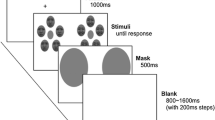Abstract
The biased positioning of faces exposed to viewers of Western portraiture has suggested there may be fundamental differences in the lateralized expression and perception of emotion. The present study investigates whether there are differences in the perception of the left and right sides of the face in real-life photographs of individuals. The study paired conscious aesthetic ratings of pleasantness with measurements of pupil size, which are thought to be a reliable unconscious measure of interest first tested by Hess. Images of 10 men and 10 women were taken from the left and right sides of the face. These images were also mirror-reversed. As expected, we found a strong preference for left-sided portraits (regardless of original or mirror-reversed orientation), such that left hemifaces elicited higher ratings and greater pupil dilation. Interestingly, this effect was true of both sexes. A positive linear relationship was also found between pupil size and aesthetic ratings such that pupil size increased with pleasantness ratings. These findings provide support for the notions of lateralized emotion, right-hemispheric dominance, pupillary dilation to pleasant images, and constriction to unpleasant images.








Similar content being viewed by others
References
Aboyoun DC, Dabbs JM (1998) The Hess pupil dilation findings: sex or novelty? Soc Behav Pers 26:415–420
Borod JC, Caron HS (1980) Facedness and emotion related to lateral dominance, sex and expression type. Neuropsychologia 18:237–241
Borod JC, Haywood CS, Koff E (1997) Neuropsychological aspects of facial asymmetry during emotional expression: a review of the normal adult literature. Neuropsychol Rev 7:41–60
Bradley MM, Miccoli L, Escrig MA, Lang PJ (2008) The pupil as a measure of emotional arousal and autonomic activation. Psychophysiol 45:602–607
Brodal A (1965) The cranial nerves. Blackwell, London
Darwin C (1872) The expression of the emotions in man and animals. D. Appleton and Company, NY
Davidson RJ (1995) Cerebral asymmetry, emotion, and affective style. In: Davidson RJ, Hughdahl K (eds) Brain asymmetry. MIT Press, MA
Demaree HA, Everhart DE, Youngstrom EA, Harrison DW (2005) Brain lateralization of emotional processing: historical roots and a future incorporating “dominance”. Behav Cogn Neurosci Rev 58:330–341
Doughty MJ (2002) Further assessment of gender-and blink pattern-related differences in the spontaneous eyeblink activity in primary gaze in young adult humans. Optom Vis Sci 79(7):439–447
Duchowski AT (2007) Eye tracking methodology: theory and practice. Springer-Verlag, London
Fridlund AJ, Izard C (1983) Electromyographic studies of facial expressions of emotions and patterns of emotion. In: Cacioppo JT, Petty RE (eds) Social psychophysiology: a sourcebook. Guilford Press, NY
Gilbert C, Bakan P (1973) Visual asymmetry in perception of faces. Neuropsychologia 11:355–362
Goldwater BC (1972) Psychological significance of pupillary movements. Psychol Bull 77:340–355
Grüsser OJ, Selke T, Zynda B (1988) Cerebral lateralization and some implications for art, aesthetic perception, and artistic creativity. In: Reutshcler I, Herzberger B, Epstein D (eds) Beauty and the brain: biological aspects of aesthetics. Berkhäuer Verlag, MA
Hess EH, Polt JM (1960) Pupil size as related to interest value of visual stimuli. Science 132:349–350
Hess EH, Beaver PW, Shrout PE (1975) Brightness contrast effects in a pupillometric experiment. Percept Psychophys 18(2):125–127
Janisse MP (1973) Pupil size and affect: a critical review of the literature since 1960. Can Psychol 14:311–329
Kowner R (1995) Laterality in facial expressions and its effect on attributions of emotion and personality: a reconsideration. Neuropsychologia 33(5):539–559
Lowenfeld IE (1999) The pupil: anatomy, physiology, and clinical applications. Butterworth-Heinemann, MA
McManus IC (2005) Symmetry and asymmetry in aesthetics and the arts. Eur Rev 13(2):157–180
McManus IC, Humphrey N (1973) Turning the left cheek. Nature 243:271–272
Powell WR, Schirillo JA (2009) Asymmetrical facial expressions in portraits and hemispheric laterality: a literature review. Laterality: asymmetries of body, brain, and cognition 14(6):545–572
Powell WR, Schirillo JA (2011) Hemispheric laterality measured in Rembrandt’s portraits using pupil diameter and aesthetic verbal judgments. Cogn Emot 25(5):868–885
Rinn WE (1984) The neuropsychology of facial expression: a review of the neurological and psychological mechanisms for producing facial expressions. Psychol Bull 95:52–77
Russell PA, George DA (1990) Relationships between aesthetic response scales applied to paintings. Empir Stud Arts 8:15–30
Sackheim HA, Gur RC (1983) Facial asymmetry and the communication of emotion. In: Cacioppo JT, Petty RE (eds) Social psychophysiology. Guilford, NY
Sackheim HA, Gur RC, Saucy MC (1978) Emotions are expressed more intensely on the left side of the face. Science 202:434–436
Schirillo J (2000) Hemispheric asymmetries and gender influence Rembrandt’s portrait orientations. Neuropsychologia 38:1593–1606
Schirillo J, Fox M (2006) Rembrandt’s portraits: approach or avoid? Leonardo 39(3):253–256
Acknowledgments
We are indebted to Jeff Muday and John Pettrocelli for help programming and to Steven Davis for help with statistical analysis.
Author information
Authors and Affiliations
Corresponding author
Rights and permissions
About this article
Cite this article
Blackburn, K., Schirillo, J. Emotive hemispheric differences measured in real-life portraits using pupil diameter and subjective aesthetic preferences. Exp Brain Res 219, 447–455 (2012). https://doi.org/10.1007/s00221-012-3091-y
Received:
Accepted:
Published:
Issue Date:
DOI: https://doi.org/10.1007/s00221-012-3091-y




